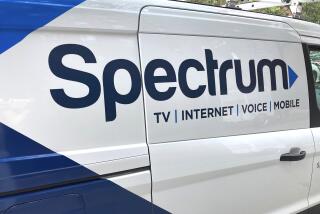Sprint Unveils Plans for Voice and Data Network
- Share via
Sprint Corp. promised to revolutionize the way people use their telephones, when it unveiled a bold plan Tuesday for a new network that would allow a customer’s standard phone line to handle multiple voice calls, faxes and high-speed Internet access simultaneously.
While other companies have been tinkering with components of Sprint’s new all-in-one system, the Westwood, Kan.-based long-distance giant is the first major company to bet its entire network on the technology that drives the Internet.
Sprint said its Integrated On-Demand Network, or ION, would drastically reduce the cost of a long-distance call--perhaps by as much as 70%--as well as allow Internet connections 100 times faster than today’s 56.6 kilobit per second dial-up modem.
In addition, Sprint’s service would also have the advantage of allowing customers to plug in various appliances--beginning with computers and telephones--to a single line.
But residential customers are unlikely to see the service until the end of 1999. Sprint, the nation’s third largest long-distance company, said it will initially target business customers, with some specific large corporations gaining access to ION in a matter of months. Small businesses could see the service beginning early next year.
The $2-billion “Project FastBreak,” under wraps for five years, underscores the fact that Americans are using telephone networks to transmit data as much as to talk on the phone. In fact, Sprint will likely change the way it bills for the service, basing fees on data transmission rather than per-minute use.
“We know this is new; we know this is momentous,” said William T. Esrey, Sprint’s chairman and chief executive officer. “We think this opens up a very exciting era.”
Significant Hurdles Await Sprint
Industry analysts predicted that AT&T;, WorldCom and other telecom giants would inevitably follow Sprint’s lead.
Still, Sprint faces several hurdles. Despite success in a yearlong trial, the company has to make the technology work on a large scale. Sprint also must strike agreements with rival local phone companies to share copper lines that lead to customers’ homes. Finally, the company has to sell the complicated service to customers, who are already bewildered by the onslaught of new technology.
“We are very, very bullish on this, but there are, without a doubt a few wrinkles to be ironed out,” said Andrew Cole, a senior manager at Renaissance Worldwide Inc., a technology consulting firm in Newton, Mass.
Sprint’s plan is the first wholesale shift away from the nation’s “circuit-switched” phone network, which sends each call on its own line--or circuit.
Instead, ION will embrace the newer “packet-switched” approach, used today mainly by computer networks. With this technology, all information--whether bits of conversations or computer files--can share space on a single line. Voice calls, faxes or Internet access are each divided into “packets” that are sent across the network to its specific destination in a kind of “electronic envelope.”
“Think of [a circuit-switched network] as an interstate highway with one car in one lane and having that lane to itself for the entire duration of the conversation,” said Josh Howell, senior vice president of corporate marketing for Level 3 Communications, a rival company based in Omaha, Neb. With packet-switched networks, “it’s like filling every lane of the highway with hundreds of cars.”
Network Powered by New Technology
The network will use a technology called asynchronous transfer mode, or ATM, which organizes and transmits the packets over the network in such a way that allows multiple uses simultaneously.
That will allow customers to carry on multiple conversations, access the Internet and send faxes over the same line at the same time.
Sprint also will use a relatively new capacity-boosting technique, called Dense Wave Division Multiplexing, that would allow one pair of Sprint fiber lines to carry 34 million calls at once.
To build the network, Sprint partnered with computer equipment maker Cisco Systems of San Jose and Bellcore, the Morristown, N.J., telecommunications research powerhouse once owned by the Baby Bell companies.
In developing ION, Sprint patented several other technologies that it said it would license to other carriers.
The backbone of the ION network is Sprint’s existing nationwide fiber-optic network but also includes high-capacity lines that extend into 25 major U.S. cities. That number will grow to 60 cities by 1999 and will bring Sprint within reach of a majority of the large businesses in those cities, according to Sprint.
But to finish the connection, Sprint would still need access to plain-old copper phone lines, which are still the exclusive domain of local phone companies, such as Pacific Bell.
Customers would need a special box that adds ATM capabilities. Sprint said the box could cost from $200 to $500, but the company has not yet decided how much customers will have to pay for it. These boxes will also serve as a meter to track customer usage.
Ongoing service charges have not yet been set, but Sprint said their cost of a voice call would drop by about 70%.
Unclear If Consumers Will See Savings
Today, most phone carriers have separate networks for voice, data communications and Internet services.
The data-switch network unveiled by Sprint would be cheaper than any of them because the technology and equipment are relatively standard, said Ken McGee, a vice president and research fellow at Gartner Group in Stamford, Conn.
Part of the price advantage also is due to a regulatory discrepancy that requires long-distance phone companies to pay access charges to local phone companies but exempts Internet service providers from the same charges.
If that discrepancy were to disappear--as some in Congress have proposed--the benefit of Sprint’s new strategy would be reduced, said Stewart Personick, vice president of information networking at Bellcore.
Even so, it is unclear whether consumers would see the savings. Sprint said it has not set its prices yet, but the company pledged that the price of its combined service--with long-distance and local phone service and Internet access--would not be higher than current levels.
Sprint’s latest offering will likely appeal mostly to businesses and residential users who have multiple phone lines or are heavy Internet users.
“We’re not talking about the person that has one line and makes $10 a month in long-distance calls; it’s not worth it to him,” Esrey said. “We’re talking about the 16 million residential customers who spend more than $110 per month. They are more than qualified for this type of service.”
ION is merely the latest entrant in an attractive market for high-speed connections. ISDN, a relatively expensive and older technology, allows customers to use one line for both phone and Internet access.
But even at its top speed, it is only about twice as fast as today’s fastest dial-up modems.
Last month, Pacific Bell announced a broad initiative that would bring another fast-access technology, called Asynchronous Digital Subscriber Line, or ADSL, to California homes this year. ADSL is 25 times faster than today’s top dial-up Internet access speeds.
ION’s ATM technology is four times faster than that. In addition, ATM has the advantage of allowing users to to quickly adjust capacity according to their needs.
But even before it becomes widely available, much can change in the fast-paced world of telecommunications.
Investors Seem Mildly Enthusiastic
“There are a lot of promises in this industry, and very little delivery in the final analysis,” said Gene Kimmelman, co-director of the Washington, D.C. office of Consumers Union. “I think it’s pretty over-hyped.”
Kimmelman and others point out, for example, it would be difficult for Sprint to get to people’s homes without smoothing out its contentious relationship with the Baby Bell phone companies, which still control the copper wires that link homes to the phone network.
Sprint could circumvent the Bells by using its own wireless network or by striking deals with cable companies that are also getting into the data transmission business.
Investors seemed mildly enthusiastic about the announcement Tuesday. Sprint shares rose 50 cents to $72.44 on the New York Stock Exchange, on a day when the overall market fell. The stock has soared 65% over the last year.
More to Read
Inside the business of entertainment
The Wide Shot brings you news, analysis and insights on everything from streaming wars to production — and what it all means for the future.
You may occasionally receive promotional content from the Los Angeles Times.











